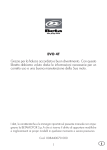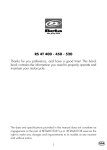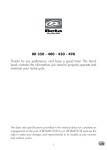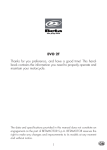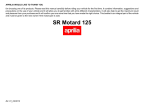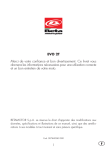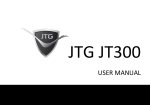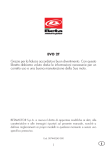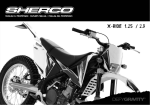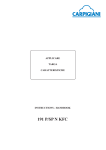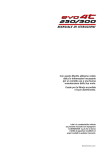Download Evolution EVO2-50 Specifications
Transcript
EVO 4T Thanks for you preference, and have a good time! This handbook contains the information you need to properly operate and maintain your motorcycle. The data and specifications provided in this manual does not constitute an engagement on the part of BETAMOTOR S.p.A. BETAMOTOR reserves the right to make any changes and improvements to its models at any moment and without notice. 1 GB IMPORTANT We recommend you to check all the tightenings after the first one or two hours’ ride over rough ground. Special attention should be paid to the following parts: • • • • • • • • • • rear sprocket ensure that the footrests are properly fixed front/rear brake levers/calipers/discs check that the plastics are properly fastened engine bolts shock absorber bolts/swingarm wheel hubs/spokes rear frame pipe connections tensioning the chain IMPORTANT For any servicing requirements, please get in contact with Betamotor’s authorized service network. GB 2 TABLE OF CONTENTS Operating instructions............................................................................. 5 Ecologic guide ....................................................................................... 5 Riding safety ......................................................................................... 6 CHAPTER 2 OPERATION .................................................................. 19 Main parts .......................................................................................... 20 Checks before and after use .................................................................. 24 Breaking in.......................................................................................... 24 Fuelling ............................................................................................... 25 Startup................................................................................................ 26 Engine shut-down ................................................................................. 26 CHAPTER 3 ADJUSTMENTS.............................................................. 27 Brakes ................................................................................................ 28 Clutch ................................................................................................. 29 Adjustment of gas clearance.................................................................. 29 Accelerator ......................................................................................... 30 Handlebar .......................................................................................... 30 Adjusting fork ...................................................................................... 30 Shock absorber.................................................................................... 31 Suspension adjustment according to the motorcyclist’s weight .................... 32 CONTENTS CHAPTER 1 GENERAL INFORMATION .............................................. 7 Vehicle identification data ....................................................................... 8 Familiarizing with the vehicle................................................................... 9 Specifications ...................................................................................... 10 Electrical system ................................................................................... 14 Recommended lubricants and liquids ...................................................... 18 CHAPTER 4 CHECKS AND MAINTENANCE ..................................... 33 Key to symbols..................................................................................... 34 Engine oil............................................................................................ 34 Coolant .............................................................................................. 36 Air filter .............................................................................................. 38 Spark plug .......................................................................................... 40 Carburetor .......................................................................................... 41 Front Brake.......................................................................................... 42 Rear brake .......................................................................................... 44 Clutch control ...................................................................................... 45 3 GB Steering gear....................................................................................... 47 Oil fork ............................................................................................... 48 Tyres................................................................................................... 52 Chain ................................................................................................. 53 Headlight ............................................................................................ 55 Rear tail light ....................................................................................... 56 Cleaning the vehicle ............................................................................. 57 Prolonged inactivity .............................................................................. 58 Scheduled maintenance vehicle ............................................................ 59 CONTENTS CHAPTER 5 TROUBLESHOOTING .................................................... 61 Troubleshooting ................................................................................... 62 GB 4 OPERATING INSTRUCTIONS • The vehicle must be accompanied by: number-plate, registration document, tax disc and insurance. • Do not carry animals, pets or loose objects that can stick out from the vehicle. • Riding without a crash helmet is forbidden. • Always ride with the low beam on. • Any modifications of the engine or other parts resulting in a power and/or speed increase are punishable by severe sanctions including the confiscation of the vehicle. • To protect your safety and that of others, always drive carefully and with your helmet on. WARNING Any modifications and tampering with the vehicle during the warranty period exempt the manufacturer from all responsibility and invalidate warranty. ECOLOGIC GUIDE • Every vehicle powered by an internal combustion engine produces an amount of noise (noise pollution) and gases (air pollution) which varies with the riding style. • The abatement of noise and air pollution levels is the duty of everybody. Avoid full-throttle starts, sudden acceleration and abrupt braking. This will reduce noise emission as well as the wear and tear of the tyres and mechanical parts, and will also allow a considerable reduction in fuel consumption. 5 GB RIDING SAFETY • Observe the Highway Code. • Always put on and fasten a homologated helmet. • Always ride with the low beam on. • Always keep the crash helmet visor clean. • Avoid wearing garments with hanging ends. • Do not keep sharp or brittle objects in your pockets while riding. • Properly adjust the rearview mirrors. • Always ride in a seated position, with both hands on the handlebars and both feet on the footrests. • Always pay attention and do not allow anything to distract you while riding. • Do not eat, drink, smoke, use a mobile phone, etc. while riding. • Do not wear headphones to listen to music while riding. • Never ride abreast with other vehicles. • Do not tow and avoid being towed by other vehicles. • Always keep a safe distance from other vehicles. • Do not sit on the vehicle when it is on its stand. • Do not start off while the vehicle is on its stand. • Do not pull out the stand when the vehicle is facing downhill. • Avoid swaying and wheelies as they are extremely dangerous for your own and other people’s safety as well as for your vehicle. • Always apply both brakes on dry roads with no gravel and sand. Using one brake may be dangerous and cause uncontrolled skidding. • To reduce the braking distance, always apply both brakes. • On wet roads and in off-road riding, drive with care and at moderate speed. Take special care in applying the brakes. • Do not start the engine in closed places. GB 6 CONTENTS Vehicle identification data ....................................................................... 8 Frame identification ........................................................................... 8 Engine identification .......................................................................... 8 Familiarizing with the vehicle................................................................... 9 Main parts........................................................................................ 9 Specifications ...................................................................................... 10 Weight ........................................................................................... 10 Vehicle dimensions .......................................................................... 10 Tyres .............................................................................................. 10 Capacities ...................................................................................... 10 Front suspension .............................................................................. 11 Rear suspension .............................................................................. 11 Front brake ..................................................................................... 11 Rear brake ..................................................................................... 11 Engine ........................................................................................... 12 Carburetor ...................................................................................... 12 Gear box ....................................................................................... 13 Electrical system ................................................................................... 14 Electrical diagram for homologated version ........................................ 14 Legend electrical diagram for homologated version ............................. 15 Electrical diagram for race version .................................................... 16 Legend electrical diagram for race version ......................................... 17 Recommended lubricants and liquids ...................................................... 18 7 1 GENERAL INFORMATION CHAPTER 1 GENERAL INFORMATION GB 1 VEHICLE IDENTIFICATION DATA FRAME IDENTIFICATION Frame identification data A are stamped on the right side of the steering head tube. GENERAL INFORMATION A GB B ENGINE IDENTIFICATION Engine identification data B are stamped in the area shown in the picture. In order to read it correctly, it is necessary to remove the silencer and disconnect the regulator connector. WARNING: Tampering with the identification numbers is severely punished by law. 8 FAMILIARIZING WITH THE VEHICLE 1 19 6 17 2 13 5 14 7 16 18 12 8 3 11 10 15 4 MAIN PARTS 1 2 3 4 5 6 7 8 9 10 Fuel tank Tank cap Silencer Rear shock absorber Headlight Rear light Side stand Fork Rider’s footrests Lower bumper 9 GENERAL INFORMATION 1 11 12 13 14 15 16 17 18 19 9 Engine Front mudguard Rear mudguard Kick-start Gear lever Rear brake lever Front brake lever Clutch lever Throttle GB 1 SPECIFICATIONS WEIGHT Dry weight ..................................................................................... 72 kg Front .......................................................................................... 36 kg Rear ........................................................................................... 36 kg GENERAL INFORMATION VEHICLE DIMENSIONS GB maximum length........................................................................ 2005 maximum width .......................................................................... 850 wheelbase................................................................................ 1305 maximum height ....................................................................... 1115 ground clearance ........................................................................ 310 saddle height.............................................................................. 660 mm mm mm mm mm mm TYRES Dimensions Front tyre Rear tyre 2,75 - 21 4,00 - 18 Pressure [Bar] Front tyre Rear tyre 0,4 ÷ 0,5 0,3 ÷ 0,4 CAPACITIES fuel tank ......................................................................................2,8 liters coolant circuit ................................................................................600 ml engine oil......................................................................................900 ml 10 1 FRONT SUSPENSION Version EVO 250 EVO 300 166 166 Wheel excursion [mm] Right fork leg Left fork leg Right fork leg Left fork leg X 7,65 X 7,65 K spring [N/mm] Shell Tellus S2 V32 SAE 6,1 Oil level [mm] (edge rod with fork compressed) Register spring preload Click in extension 65 125 65 125 X Full open X Full open Full open X Full open X REAR SUSPENSION Version EVO 250 EVO 300 k spring 70N/mm 70N/mm 136 136 Length (spring in its seat) [mm] Oil type oil titan SAF 5045 Eu 137 RED Click in extension Full open FRONT BRAKE disk-type with hydraulic control Ø 185 mm Full open GENERAL INFORMATION Oil type REAR BRAKE disk-type with hydraulic control Ø 160 mm 11 GB 1 ENGINE Version EVO 250 EVO 300 Single-cylinder, 4-stroke Single-cylinder, 4-stroke 77 x 53,6 84 x 53,6 Displacement [cm3] 249,6 297 Pressure ratio 11,5:1 11,4:1 carburetor carburetor EVO 250 EVO 300 Type Bore x stroke GENERAL INFORMATION Fuel system CARBURETOR Version Carburetor type Homologated Competition* Homologated SE BSR33-79 Competition* SE BSR33-79 Main jet 120 127,5 120 120 Slow jet 17,5 27,5 17,5 27,5 Start jet 60 60 60 60 Needle 5D132 5D132 5D132 5D132 Needle position (from top) 2° 3° 2° 3° Air screw turns (from all closed) 3+1/2 2+1/2 3+1/2 2 YES NO YES NO Spacer * Such modification makes the vehicle non-compliant with the road regulations in force. Its use must be limited to the sole private circuits which are closed to circulation. Cooling system ......................................... forced liquid circulation by pump Spark plug ............................................................................ NGK CR7EB Clutch .................................................................................. wet, multidisc GB 12 GEAR BOX Secondary drive EVO 250 18/63 13/36 15/36 16/30 24/27 28/21 EVO 300 18/63 13/36 15/36 16/30 24/27 28/21 Homologated Competition* Homologated Competition* 42/13 42/11 42/13 42/11 * Such modification makes the vehicle non-compliant with the road regulations in force. Its use must be limited to the sole private circuits which are closed to circulation. Ignition ...........................................................electronic Hidria 12V-120W 13 GENERAL INFORMATION Version Primary drive Gear ratio 1st gear Gear ratio 2nd gear Gear ratio 3rd gear Gear ratio 4th gear Gear ratio 5th gear 1 GB ELECTRICAL SYSTEM ELECTRICAL DIAGRAM FOR HOMOLOGATED VERSION GENERAL INFORMATION 1 GB 14 LEGEND ELECTRICAL DIAGRAM FOR HOMOLOGATED VERSION R.H. front turn signal with bulb 12V - 10W Headlamp (double filament bulb) 12V-35/35W Position light with bulb 12V - 5W High beam indicator light with bulb 12V 1,2W Dashboard indicator light with bulb 12V 1,2W Turn signal indicator light with bulb 12V 1,2W L.H. front turn signal with bulb 12V - 10W Engine stop button Horn button Light switch Turn signal switch Blinker Rear brake stop button L.H. rear turn signal with bulb 12V - 10W Tail light with bulb 12V - 5/21W R.H. rear turn signal with bulb 12V - 10W Connector connected to the fuel cock Condenser 4700µF - 25V Switch for change mapping Pick-up Generator H.T. coil Electronic control unit Regulator 12V Thermal switch Electrofan Frame earth Horn 12V Frame earth Front brake stop button Key to colours Bi = White Ve = Green Ma = Brown Vi = Purple Bl = Ne = Gi = Rs = Blue Black Yellow Red 15 1 GENERAL INFORMATION 1) 2) 3) 4) 5) 6) 7) 8) 9) 10) 11) 12) 13) 14) 15) 16) 17) 18) 19) 20) 21) 22) 23) 24) 25) 26) 27) 28) 29) 30) Ar Az Ro Gr = = = = Orange Sky-blue Pink Grey GB ELECTRICAL DIAGRAM FOR RACE VERSION GENERAL INFORMATION 1 GB 16 1 LEGEND ELECTRICAL DIAGRAM FOR RACE VERSION Headlamp with bulb 12V-20W Horn 12V Fuel cock Horn button Engine stop button Condenser 4700µF - 25V Light switch (black) Switch for change mapping (yellow) Tail light with bulb 12V - 3W Generator Pick-up H.T. coil Electronic control unit Regulator 12V Thermal switch Electrofan Frame earth Key to colours Bi = White Ve = Green Ma = Brown Vi = Purple Bl = Ne = Gi = Rs = Blue Black Yellow Red 17 GENERAL INFORMATION 1) 2) 3) 4) 5) 6) 7) 8) 9) 10) 11) 12) 13) 14) 15) 16) 17) Ar Az Ro Gr = = = = Orange Sky-blue Pink Grey GB 1 RECOMMENDED LUBRICANTS AND LIQUIDS For better operation and longer vehicle life, we advise you to use the products listed in the following chart: GENERAL INFORMATION Engine Oil: GB 850cc Motul 7100 10w40 (For Competition use Motul 300V 10w40) Brake Fluid Motul RBF 600 Coolant/Antifreeze Motul Motocool Expert Fork Oil Motul Factory Line 5 wt. Air Filter Oil Motul Air Filter Oil Air Filter Cleaner Motul Air Filter Clean Grease Motul Tech 300 18 CONTENTS Main parts .......................................................................................... 20 Fuel cock ........................................................................................ 20 Starter ............................................................................................ 20 Hot start ......................................................................................... 20 Clutch lever .................................................................................... 21 LH switch ........................................................................................ 21 RH switch ....................................................................................... 21 Front brake lever and gas control ...................................................... 22 Gearchange lever............................................................................ 22 Brake pedal .................................................................................... 22 Kick-start ........................................................................................ 22 Checks before and after use .................................................................. 24 Breaking in.......................................................................................... 24 Fuelling ............................................................................................... 25 Startup................................................................................................ 26 Engine shut-down ................................................................................. 26 19 2 OPERATION CHAPTER 2 OPERATION GB 2 MAIN PARTS FUEL COCK Fuel valve has two positions: OPERATION C : OFF Automatic. If the engine is shut off, the fuel supply is switched off and the fuel cannot flow from the tank to the carburetor. A: fuel supply always enabled. The fuel passes from the tank to the carburetor even with the engine off. STARTER 1 2 The starter lever 1 is located on the carburettor. To use, pull it out. HOT START The hot start 2 is located on the intake manifold. To use, pull it out. GB 20 2 CLUTCH LEVER Clutch lever 1 is fitted to the left-hand side of the handlebars. Screw A can be used to alter the home position of the lever (see Adjustments). 1 A LH SWITCH OPERATION The off switch is positioned on the left-hand side of the handlebar and consists of the following: shutdowns engine: it is necessary to hold it until the engine stops. RH SWITCH 2 The lights and services switch is located on the right-hand side of the radiator and consists of the following: 1 Rear light power on/off 1 2 Mapping change switch By acting on the switch shown in the figure, it is possible to select one of two possible mappings for the ignition advance. With the switch in position A, “soft” mapping more suited to muddy terrain and for a gentler response of the bike is selected. With the switch in position B “hard” mapping that is more suitable for dry land and for a more aggressive response of the bike is selected. 21 A B GB 2 FRONT BRAKE LEVER AND GAS CONTROL 1 The front brake lever 1 and the gas throttle 2 are located on the right side of the handlebar. 2 OPERATION 4 3 2 N 5 GEARCHANGE LEVER Gearchange lever is fitted to the left side of the engine. The positions corresponding to the different gears are shown in the figure. 1 BRAKE PEDAL Brake pedal is located in front of the righthand footrest. KICK-START The kick-start pedal is located on the right side of the engine. The upper part is rotatable GB 22 SIDE STAND Press down side stand with the foot and lean the vehicle against it. Ensure that the ground is solid and the vehicle stands steadily. 2 OPERATION WARNING! The kickstand has an automatic closing device. When the vehicle weight on the kickstand is reduced, it closes automatically. 23 GB OPERATION 2 CHECKS BEFORE AND AFTER USE For safe driving and long vehicle life you should: • Check all fluid levels. • Check the correct operation of the brakes and brake pad wear (page 43). • Check pressure, general condition and thickness of tread (page 10). • Check that the spokes are properly tightened. • Check the chain tension (page 54). • Check the adjustment and the operation of all the cable controls. • Inspect all the nuts and bolts. • With the engine running, check the operation of the headlight, the rear and brake lights, the indicators, the warning lights and the horn. • Wash the motorcycle thoroughly after off-road use (page 58). BREAKING IN The breaking-in period lasts approximately 10 hours, during which it is advisable to: • Avoid travelling at constant speed. • For the first 3 hours of use, the engine should only be used at up to 50% of its power. The engine speed should not exceed 7000 rpm. • For the next 7 hours of use, the engine should only be used at up to 75% of its power. WARNING: After the first 3 hours to replace the engine oil. This procedure should be followed each time piston, piston rings, cylinder, crankshaft or crankshaft bearings are replaced. GB 24 2 FUELLING Use unleaded gasoline. Fuel tank capacity is shown on page 10. To open the fuel tank’s cap, turn it anticlockwise. OPERATION To close the fuel tank’s cap, set it on the tank and crew it clockwise. 25 GB 2 STARTUP Set the fuel tank tap to A (see page 20). - Check that the gears are in neutral (page 22). - Pull the clutch lever (page 21). KICKSTART (page 22): depress the kick-starter with a sharp movement of the foot. OPERATION ATTENTION Once the pedal has been depressed, release it immediately. This avoids jolts to the entire ignition group and to the foot. COLD STARTING: operate the starter (page 20), start the vehicle, wait a few seconds, then move the starter back to its starting position. HOT STARTING: operate the hot start (page 20), WITHOUT stepping on the gas to start the vehicle, wait a few seconds, then return the hot start to the initial position. Once you start the engine, turn the fuel cock to the “C” position. STARTING WHEN THE BIKE HAS FALLEN OVER: If the bike falls over, the carburettor float bowl may empty. In this case, follow the procedure for starting a warm engine. ENGINE SHUT-DOWN To shut-down the engine: - press the button on the left switch unit (see page 21). NOTE: With the engine off, make sure the fuel cock is set to C (page 20). GB 26 CONTENTS Brakes ................................................................................................ 28 Front brake ..................................................................................... 28 Rear Brake...................................................................................... 28 Clutch ................................................................................................. 29 Adjustment of gas clearance.................................................................. 29 Accelerator ......................................................................................... 30 Adjusting the idle speed ................................................................... 30 Handlebar .......................................................................................... 30 Adjusting fork ...................................................................................... 30 Adjusting the rebound damper .......................................................... 30 Adjusting the spring preload ............................................................. 31 Shock absorber.................................................................................... 31 Adjusting the rebound damper .......................................................... 31 Adjusting the spring preload ............................................................. 32 Suspension adjustment according to the motorcyclist’s weight .................... 32 27 3 ADJUSTMENTS CHAPTER 3 ADJUSTMENTS GB 3 BRAKES 1 FRONT BRAKE 2 The front brake is disk type with hydraulic control. The position of the lever is controlled through the use of register 1. Once the position of the lever has been changed, register 2 must be changed to restore the initial correct clearance. ADJUSTMENTS WARNING: reduced play causes brake overheating leading to sudden lockup. REAR BRAKE 1 2 The rear brake is disk type with hydraulic control. You may adjust pedal height by means of register 1. Once you change the original pedal position you need to modify regulator 2 on the brake pump to allow you to reset the correct pump travel. WARNING: reduced play causes brake overheating leading to sudden lockup. GB 28 CLUTCH 2 The idle stroke of push rod must not be less than 0.9 mm 0,9 mm ATTENTION: reduced clearance leads to premature wear of the discs and overheating of the entire clutch group. ADJUSTMENT OF GAS CLEARANCE 2 The throttle control cable should always have a 3-5 mm play. In addition, the idle speed should not change when the handlebars are fully rotated to the left or right. 3 1 ADJUSTMENTS The position of the lever is controlled through the use of register 1. Once the position of the lever has been changed, register 2 must be changed to restore the initial correct clearance. 1 3 To adjust the clearance proceed as follows: - Loosen ring 1. - Rotate register 2 with respect to sheath 3. - Tighten ring 1. 29 GB 3 ACCELERATOR ADJUSTING THE IDLE SPEED A In order to perform this operation correctly, we advise you to do it when the engine is hot, connecting an electric revolution counter to the spark plug wire. Then use a screwdriver on register screw A to calibrate the minimum with 1.100÷1.200 rpm. ADJUSTMENTS HANDLEBAR The handlebar can be adjusted by rotating it back and forth. - To adjust the handlebar loosen screws 1. - Position the handlebar according to requirements. - Tighten to the torque indicated. 1 20Nm ADJUSTING FORK ADJUSTING THE REBOUND DAMPER 1 The hydraulic brake unit in extension determines the behaviour in the extension phase of the fork and can be adjusted using screw 1. Turning clockwise increases the action of the brake in extension, while rotating counter-clockwise decreases the action of the brake in extension. For standard calibration, refer to page 11. GB 30 3 ADJUSTING THE SPRING PRELOAD Spring preload is adjusted by means of screw 2. Turning clockwise will increase the preload, while rotating counter- clockwise decreases the preload. 2 ADJUSTMENTS For standard calibration, refer to page 11. SHOCK ABSORBER ADJUSTING THE REBOUND DAMPER The hydraulic brake unit in extension determines the behaviour in the extension phase of the shock absorber and can be adjusted using screw 1. Turning clockwise increases the action of the brake in extension, while rotating counter-clockwise decreases the action of the brake in extension. 1 For standard calibration, refer to page 11. NOTE: for adjustment use a T-handle wrenches with jointed hexagonal socket. 31 GB 3 ADJUSTING THE SPRING PRELOAD To adjust the spring preload, use the procedure described below. Loosen counter-ring 1, rotate ring 2 clockwise to increase the spring preload (and consequently the shock absorber preload) or anticlockwise to decrease it. After obtaining the desired preload, turn counter-ring 1 until it stops against adjusting ring 2. 2 1 ADJUSTMENTS For standard calibration, refer to page 11. GB NOTE: for movement of the rings use a specific sector key with square pin SUSPENSION ADJUSTMENT ACCORDING TO THE MOTORCYCLIST’S WEIGHT The following table shows the approximate calibration of the suspension adjustment according to the motorcyclist’s weight. w < 70 Kg 70 Kg < w < 80 Kg 80 Kg < w Adjustment Adjustment Adjustment Fork Shock absorber Fork Shock absorber Fork Standard Standard + 5 turns preload + 1,5 turns preload + 10 turns preload 32 Shock absorber + 3 turns preload CONTENTS Key to symbols..................................................................................... 34 Engine oil............................................................................................ 34 Check the level................................................................................ 34 Replacement ................................................................................... 34 Coolant .............................................................................................. 36 Check the level................................................................................ 36 Replacement ................................................................................... 37 Radiator grill ................................................................................... 38 Air filter .............................................................................................. 38 Removing and fitting air filter ............................................................ 38 Cleaning air filter ............................................................................ 39 Spark plug .......................................................................................... 40 Carburetor .......................................................................................... 41 Draining the carburetor float chamber ................................................ 41 Front Brake.......................................................................................... 42 Check the level of the front brake fluid ............................................... 42 Restoring the level of the front brake fluid ........................................... 42 Bleeding the front brake ................................................................... 43 Front brake lining control .................................................................. 43 Rear brake .......................................................................................... 44 Check the level of the rear brake fluid ................................................ 44 Restoring the level of the rear brake fluid ............................................ 44 Bleeding the rear brake .................................................................... 44 Rear brake lining control .................................................................. 45 Clutch control ...................................................................................... 45 Check oil level ................................................................................ 45 Bleeding clutch control ..................................................................... 46 Steering gear....................................................................................... 47 Check of steering gear ..................................................................... 47 Oil fork ............................................................................................... 48 Removing legs................................................................................. 48 Oil replacement right leg .................................................................. 48 Oil replacement left leg .................................................................... 49 Legs assembly and parts................................................................... 50 Linkage rear suspension ................................................................... 51 Tyres................................................................................................... 52 Chain ................................................................................................. 53 Check and adjust tightening chain ..................................................... 53 Headlight ............................................................................................ 55 Replacing the headlight bulbs ........................................................... 55 Rear tail light ....................................................................................... 56 Cleaning the vehicle ............................................................................. 57 Prolonged inactivity .............................................................................. 58 Scheduled maintenance vehicle ............................................................ 59 33 4 CHECKS AND MAINTENANCE CHAPTER 4 CHECKS AND MAINTENANCE GB 4 KEY TO SYMBOLS Tightening torque Threadlocker medium intensity CHECKS AND MAINTENANCE ENGINE OIL CHECK THE LEVEL 1 MAX MIN 2 Let the engine run for a few minutes then turn it off. Keep the vehicle in vertical position relative to the ground. Wait a few minutes and check the oil level through the window 1. The level must be between the limits indicated in the picture. Otherwise restore the oil level through 2. Use the oil indicated on page 18 in the “Recommended lubricants and liquids” table. REPLACEMENT 3 GB The engine oil level must be checked when the engine is warm. Always perform the replacement when engine is hot: - Position the drive on a flat base ensuring stability. - Place a container under the engine. - Unscrew the filler cap 2 and the drain plug 3. - Completely empty the crankcase. - Close the cap 3. 34 4 - Unscrew the plug 4 in the left-hand casing and use pliers to extract the filter. Clean it carefully and blow it through with compressed air. Check for damage to the O-rings, and replace them if necessary. Refit all the parts and tighten the plug to 15 Nm. CHECKS AND MAINTENANCE 4 - Perform the same procedure for the filter located on the right side of crankcase. - Put a drawn pan under the engine closer to the paper filter cover 1 and then unscrew 2 the cover. 1 2 10Nm 35 GB 4 - Extract the paper filter using pliers. Check the condition of the O-ring too, and replace it if necessary. Change the filter and refit the cover, tightening the three M6x20 bolts to 10 Nm. CHECKS AND MAINTENANCE - Pour in the quantity of oil indicated on page 10. - Use the oil indicated on page 18 in the “Recommended lubricants and liquids” table. - Close the filler cap 1. WARNING: Hot oil can cause severe burns! COOLANT CHECK THE LEVEL Keep the vehicle in vertical position relative to the ground. 1 The level of the coolant must be checked when the engine is cold. Use the following procedure: Unscrew cap 1 and ensure that the liquid is visible in the lower portion of the loading tube. Where the liquid is not visible in the lower part of the loading tube position the vehicle as in the figure and then top up. Use the liquid indicated on page 18 in the “Recommended lubricants and liquids” table. GB 36 4 REPLACEMENT Position the vehicle on a flat base and in a stable manner. Replacement of the coolant must take place when the engine is cold. 1) Unscrew cap 1. 2) Unscrew screw 2, collecting the liquid in a container. 10Nm 2 3) Drain the liquid. 4) Tighten screw 2 applying the specific washer. 5) Unscrew drain screw 3 and fill until the liquid starts to overflow the screw. 6) Tighten screw 3. 3 10Nm CHECKS AND MAINTENANCE 1 7) Place the vehicle as shown and proceed to filling. 8) Reapply the loading cap 1. The amounts of liquid are shown on page 10. 37 GB 4 RADIATOR GRILL Should the grill be obstructed proceed as follows: Remove the grill by pulling it towards the front of the vehicle. Shake and wash the grill. CHECKS AND MAINTENANCE Reapply the grill pushing it towards the radiator. GB AIR FILTER 1 Check after every ride. REMOVING AND FITTING AIR FILTER To access the filter: - Loosen the fastening screw 1 of the rear cover. 2 - Remove the filter frame and the filter by unscrewing the screw 2. WARNING: After every intervention, check that nothing has been left inside the filter box. - Reassemble by performing the operations in reverse order. 38 CLEANING AIR FILTER - Thoroughly wash the filter with water and soap. 4 - Dry the filter. - If necessary also clean the interior of the filter box. WARNING: Do not clean the filter with gasoline or petrol. NOTE: If the filter is damaged, replace it immediately. Verify the integrity of water proofing gaskets on air box shown in the picture. Change them if these are damaged. To replace, contact authorised Betamotor customer service. WARNING: Never use the vehicle if the air filter is not in place. The infiltration of dust and dirt can cause damage and considerable wear. CHECKS AND MAINTENANCE - Wet the filter with specific oil and then remove the excess oil to prevent it from dripping. WARNING: After each operation check that no object is left in the filter box. 39 GB 4 SPARK PLUG CHECKS AND MAINTENANCE 0,5÷0,6 mm GB Keeping the spark plug in good condition will reduce fuel consumption and increase engine performance. To perform the check, simply slide off the electrical connection tube and unscrew the spark plug. Examine the distance between the electrodes with a feeler. This distance should be from 0.5÷0.6 mm. If it is not, it may be corrected by bending the earth electrode. Check as well that there are no cracks in the insulation or corroded electrodes. If so, replace immediately. When replacing the spark plug, screw it in by hand until it stops, then tighten with a wrench. WARNING: Do not check while the engine is hot. 40 4 CARBURETOR DRAINING THE CARBURETOR FLOAT CHAMBER If the carburetor tank needs to be emptied, proceed as described. Perform the operation once the engine is cold. Turn the fuel cock to the “C” position (see page 20) Place tube 1 in a container to gather the fuel that fl ows out. Loosen screw 1 and drain the fuel until complete emptying of the tank. Tighten screw 1. 41 1 CHECKS AND MAINTENANCE WARNING Fuel is flammable and toxic and must be handled with great care. Never work on the fuel system near heat sources or open flames. Always allow the engine to cool down before working on the fuel system. Wipe off any excess fuel with a rag. Materials soaked in fuel are also flammable. In case of ingestion or contact with sensitive parts of the body immediately seek medical attention. Fuel is to be disposed of as prescribed by law. 2 GB 4 FRONT BRAKE A CHECK THE LEVEL OF THE FRONT BRAKE FLUID CHECKS AND MAINTENANCE Check the level of the brake fluid through sight A. The level of the fluid should never fall below the mark in the sight. GB 1 RESTORING THE LEVEL OF THE FRONT BRAKE FLUID To restore the level of the brake fluid, loosen the two screws 1, lift cap 2 and add brake fluid until its level is 5 mm below the upper rim of the reservoir. 2 Use the liquid indicated on page 18 in the “Recommended lubricants and liquids” table. WARNING: The brake fluid is extremely corrosive. Take care not to spill it on the paintwork. 42 4 BLEEDING THE FRONT BRAKE 1 2 CHECKS AND MAINTENANCE To bleed air from the front brake circuit, proceed as follows: •Remove the rubber cap 1 from the valve 2. •Open the sump cap. •Insert one end of a transparent tube into a container. •Pump with the brake lever 2/3 times and keep the lever pressed. •Unscrew the valve and let the oil drain. •If are still visible in the tube repeat above operation until obtaining a continuous outflow of oil within no air bubbles. •Close the valve and release the lever. NOTE: During this procedure, continuously top up the brake pump thank to replace the oil that is out flowing. •Remove the tube. •Replace the rubber cap. Close the oil reservoir cap. FRONT BRAKE LINING CONTROL In order to verify the wear condition of front brake is enough to view the caliper from the bottom, where is possible to glimpse the brake lining tails which will have to show a brake of 2 mm in thickness. If the stratum is lesser let’s start replacing them. 2 mm NOTE: Perform the check according to the times shown in the table on page 59. To replace, contact authorised Betamotor customer service. 43 GB 4 REAR BRAKE CHECK THE LEVEL OF THE REAR BRAKE FLUID Check the level of the brake fluid through sight A. The level of the fluid should never fall below the mark in the sight. 1 CHECKS AND MAINTENANCE 2 GB RESTORING THE LEVEL OF THE REAR BRAKE FLUID To restore the level of the brake fluid, loosen the two screws 1, lift cap 2 and add brake fluid until its level is 5 mm below the upper rim of the reservoir. A Use the liquid indicated on page 18 in the “Recommended lubricants and liquids” table. WARNING The fluid is extremely corrosive. Take care not to spill it on the paintwork. BLEEDING THE REAR BRAKE 1 2 To bleed air from the rear brake circuit, proceed as follows: • Remove the rubber cap 1 from the valve 2. • Open the sump cap. • Insert one end of a transparent tube into a container. • Pump with the brake lever 2/3 times and keep the lever pressed. • Unscrew the valve and let the oil drain. • If are still visible in the tube repeat above operation until obtaining a continuous outflow of oil within no air bubbles. • Close the valve and release the lever. 44 4 NOTE: During this procedure, continuously top up the brake pump thank to replace the oil that is out flowing. •Remove the tube. •Replace the rubber cap. REAR BRAKE LINING CONTROL CHECKS AND MAINTENANCE Close the oil reservoir cap. 2 mm In order to verify the wear condition of rear brake is enough to view the caliper from the back side, where is possible to glimpse the brake lining tails which will have to show a brake of 2 mm in thickness. If the stratum is lesser let’s start replacing them. NOTE: Perform the check according to the times shown in the table on page 59. To replace, contact authorised Betamotor customer service. CLUTCH CONTROL 2 CHECK OIL LEVEL To check the oil level in the clutch pump, first remove cover 1. Remove the two screws 2 and take off cover 1 together with the rubber bellows. With the clutch pump in a horizontal position, the level of the oil should be 5 mm below the upper rim. 45 1 GB 4 If the level is lower than indicated proceed with refilling. Use the liquid indicated on page 18 in the “Recommended lubricants and liquids” table. CHECKS AND MAINTENANCE WARNING: The fluid is extremely corrosive. Take care not to spill it on the paintwork. BLEEDING CLUTCH CONTROL 1 2 • Remove the rubber cap 1 from the valve 2. • Open the sump cap. • Insert one end of a trasparent tube into a container. • Pump with the brake lever 2/3 times and keep the lever pressed. • Unscrew the valve and let the oil drain. • If are still visible in the tube repeat above operation until obtaining a continuous outflow of oil within no air bubles. • Close the valve and release the lever. NOTE: During this procedure, continuosly top up the brake pump thank to replace the oil that is out flowing. • Remove the tube. • Replace the rubber cap. GB 46 4 STEERING GEAR CHECK OF STEERING GEAR CHECKS AND MAINTENANCE Periodically check the play in the steering sleeve by moving the fork back and forth as shown in the figure. Whenever you feel play, adjust as described below: Loosen the screws 1. 1 10Nm Loosen the screw 2. 3 Take up the play by means of nut 3. Tighten the screws to the specified torque values. 2 10Nm 47 GB 4 OIL FORK CHECKS AND MAINTENANCE The procedure for changing the oil in the forks is provided only for information. We recommend having the operation performed by a BETAMOTOR authorized workshop. REMOVING LEGS To replace, proceed as follows: Position the vehicle on the central bike stand. 1 Remove the front wheel. Remove the mudguard, the brake caliper and brake disc cover. Loosen the screws 1 and pull off the stems. 2 OIL REPLACEMENT RIGHT LEG Unscrew upper plug 2. Unscrew fixing lock nut and take off the plug. Unscrew the fixing screw of the cartridge positioned under the fork leg, and extract the cartridge. GB 48 Empty the fork leg and the cartridge, draining all the oil inside. 3 4 Reassemble the cartridge on the fork leg tightening the fixing screw, then refill oil in the cartridge. Use the liquid indicated on page 18 in the “Recommended lubricants and liquids” table. Reassemble the plug on the rod, tighten the lock nut and, extending the fork leg. OIL REPLACEMENT LEFT LEG Unscrew upper plug 3. Remove the spring and totally empty the oil. Pour in the quantity of liquid indicated on page 11. Reassemble the spring and extend fork leg. Apply and tighten cap 3. 49 CHECKS AND MAINTENANCE Pour in the quantity of liquid indicated on page 11. GB 4 LEGS ASSEMBLY AND PARTS Apply the legs to the vehicle and tighten the screws 1 to the torque indicated. CHECKS AND MAINTENANCE 1 Grease the wheel bolt. Apply wheel and wheel bolt. Apply brake caliper, disc cover and fender. Tighten to the torque indicated. 10Nm Place the vehicle on the ground. Compress and release the fork 3-4 times. Tighten the wheel bolt and the screws of the foot. 25Nm ATTENTION: Tightening of the screws should be carried out by adjusting the torque wrench to to the stability torque with repeated tightening until stability torque has been achieved. Tighten to the torque indicated. 50Nm GB 10Nm ATTENTION: Tightening of the screws should be carried out by adjusting the torque wrench to to the stability torque with repeated tightening until stability torque has been achieved. 10Nm 50 LINKAGE REAR SUSPENSION To guarantee an optimal operation and the longest lifetime of the progressive linkage of the rear suspension, it is recommended to check after every race/run the correct tightening of the bolt. 45Nm 4 30Nm 45Nm To check the upper shock absorber fastening proceed as follow: Remove screws 1 and 2 (two per side). Remove the mudguard. 10Nm 2 At the end refit the screws 1 and 2. Tighten to the torque indicated. NOTE: It is recommended not to wash with water jets at high pressure in the zone of the linkage. 1 10Nm CHECKS AND MAINTENANCE Verify that the result of the suspension bolts to specified torque. Perform the check according to the times indicated in the table on page 59. To verify device, contact authorised Betamotor customer service. 51 GB CHECKS AND MAINTENANCE 4 GB TYRES Only fit tyres approved by BETAMOTOR. Unsuitable tyres can adversely affect the road holding of the vehicle. • To protect your safety, immediately replace any damaged tyres. • Slick tyres adversely affect the road holding of the vehicle, especially on wet roads and in off-road riding. • Insufficient pressure results in abnormal wear and overheating of the tyres. • The front and rear tyres must have the same tread design. • Always measure the inflating pressures when the tyres are cold. • Keep the tyre pressures within the prescribed range. 52 4 CHAIN Checking the drive chain periodically to ensure longer chain life. Always keep it lubricated and clean of deposited dirt. CHECKS AND MAINTENANCE Take special care in preventing the lubricant from coming into contact with the rear tyre or brake disc, otherwise the tyre grip and the action of the brake would be greatly reduced, making it very difficult to control the vehicle. CHECK AND ADJUST TIGHTENING CHAIN Position the vehicle on the central bike stand. If the distance between chain and swingarm is less than 20 mm proceed with adjustment. 20mm Loosen the pin 1. Rotate register 2 until the distance between chain and swingarm is that recommended. 2 53 1 GB 4 Rotate register 3 into the same position as register 2. Ensure the distance between chain and swingarm is that recommended. If the distance between chain and swingarm is not that recommended proceed to readjustment. CHECKS AND MAINTENANCE 3 GB Tighten the pin to the torque indicated. 80Nm 54 Keep the headlight glass clean at all times (page 57). REPLACING THE HEADLIGHT BULBS 1 Dismantle the headlight mask removing the two retaining screws 1 indicated in the figure. Remove the screws 2 indicated in the figure. 2 CHECKS AND MAINTENANCE 4 HEADLIGHT Take out the bulb assembly from the bulb holder. Remove the bulb from the connectors and carry out replacement. To reassemble, proceed inversely as described above. 55 GB 4 REAR TAIL LIGHT Keep the tail light glass clean at all times (see page 57). CHECKS AND MAINTENANCE Remove the screws indicated in the figure. GB Remove the bulb holder from its place. Remove the bulb. To reassemble, proceed inversely as described above. 56 CLEANING THE VEHICLE WARNING: Do not clean your vehicle with a high-pressure device with a strong jet of water. Excessive pressure can reach electrical components, connectors, flexible cables, bearings, etc and can damage or destroy them. 4 When cleaning, avoid direct exposure to sunlight. Close off the exhaust system to prevent water from entering. Avoid directing the jet of water onto the air filter box cover. Use water jet to soften the dirt and mud accumulated on the paintwork, then remove them with a soft bodywork sponge soaked in water and shampoo. Subsequently rinse well with water, and dry with air and cloth or suede leather. Proceed to the emptying of the filter box using the appropriate ventilation and drying. Detergents pollute water. Always wash the vehicle in areas equipped for collection and purification of the washing liquids. After cleaning, ride a short distance until the engine reaches operating temperature. WARNING: braking effect is reduced with wet brakes. Operate the brakes cautiously to allow them to dry. Push back the handlebar control covers, so that water can evaporate. When the bike is completely dry and cooled down, lubricate all moving parts. Treat all plastic and painted components with non-aggressive detergents or products that are specific for the care of the motorcycle. CHECKS AND MAINTENANCE WARNING: Wash motorbikes frequently that are used near the sea (salty air) and on roads subject to salt spreading in winter. Cover with a film of oil or silicone spray unpainted parts and the most exposed parts such as wheels, forks and swingarm. Do not treat rubber parts and brakes. To prevent malfunction of the electrical system, treat electric contacts and switches with electrical contact spray. 57 GB CHECKS AND MAINTENANCE 4 GB PROLONGED INACTIVITY A few simple operations should be performed to keep the vehicle in good condition whenever it is to remain inactive for a long period (e.g. during the winter): • Thoroughly clean the vehicle. • Reduce the tyre pressures by approximately 30 percent, and if possible raise the tyres off the ground. • Remove the spark plug and pour a few drops of engine oil into the spark plug hole. Make the engine turn a few times by operating the kick-start (where available) and then replace the spark plug. • Cover the unpainted parts, excepting the brakes and the rubber parts, with a film of oil or spray silicone. • Protect the vehicle with a dust cover. •Drain the carburetor tank as described at page 41. AFTER PROLONGED INACTIVITY • Restore the tyre inflating pressures. • Check the tightening of all the screws having an important mechanical function. 58 Coupon 9 360 hours or 9.000 Km Coupon 8 320 hours or 8.000 Km Coupon 7 280 hours or 7.000 Km Coupon 6 240 hours or 6.000 Km Coupon 5 200 hours or 5.000 Km Coupon 4 160 hours or 4.000 Km Coupon 3 120 hours or 3.000 Km Coupon 2 80 hours or 2.000 Km Coupon 1 40 hours or 1.000 Km End of running-in 5 hours Engine Spark plug P S S S S S S S S S Clutch C C C C C C C C C C Cylinder C C C C Piston sealing rings C C C C Piston S S S Water pump shaft C Oil seal water pump shaft S C S S C S S S C S S C S Coolant C C S C S C S C S Gear oil S S S S S S S S S S Oil net filters P P P P P P P P P P Paper filter S S S S S S S S S S Connecting rod S S Crankshaft bearings S S Gear C C Vehicle Rear shock absorber Linkage rear suspension C C C C C C C C C T T C T C T C T C Fork oil S S C S S C T S Steering bearings and steering clearance C C C C C C C C C C Wheel bearings C C C C C C C C C C Spokes C C C C C C C C C C Air filter P P S P S P S P S P Throttle control C C C C C C C C C C Braking system C C C C C C C C C C Oil pumps brakes C C C C C C C C C C Oil clutch actuator C C C C C C C C C C Transmission chain C C C C C C C C C C State and tyre pressure C C C C C C C C C C Electrical system C C C C C C C C C C CHECKS AND MAINTENANCE 4 SCHEDULED MAINTENANCE VEHICLE Key C S R Check (Clean, adjust, lubricate, replace as necessary) Replace/renew Adjust P T 59 Clean Tighten GB GB 60 CHAPTER 5 TROUBLESHOOTING TROUBLESHOOTING CONTENTS Troubleshooting ................................................................................... 62 Alphabetical index ............................................................................... 63 5 61 GB 5 TROUBLESHOOTING PROBLEM CAUSE The engine turns over but Fuel cock in C position will not start Dirty carburettor jets Spark plug dirty Spark gap wrongly adjusted Fault in the ignition system TROUBLESHOOTING The power delivered by the engine is insufficient Tank vent obstructed Fuel system dirty Defective ignition system Lack of fuel Loose or oxidized connector or ignition coil Radiator grill blocked Radiator (air side) blocked Forced ventilation absent Low coolant Silencer partly clogged Carburation too lean Front braking poor Brake pads worn Rear braking poor Air or humidity in the hydraulic circuit Brake pads worn Air or humidity in the hydraulic circuit GB Contact authorised BETAMOTOR customer service Check the tank vent Contact authorised BETAMOTOR customer service Move the fuel cock to A Refuel Poor carburettor seal Engine overheats (liquid flows out/vapor from the vent radiator) Contact authorised BETAMOTOR customer service Clean or replace the spark plug Restore the spark gap (page 40) Contact authorised BETAMOTOR customer service Clean the air filter Air filter dirty The motor stops or splutters REMEDY Turn the fuel cock in A position 62 Make sure that the sleeve between carburetor and engine is intact Check the connector. Clean and treat with specific spray Remove and clean the grill (page 38) Clean the radiator Check that the cooling fan is working correctly Check the coolant level (page 36) Contact authorised customer service Contact authorised customer service Contact authorised customer service Contact authorised customer service Contact authorised customer service Contact authorised customer service BETAMOTOR BETAMOTOR BETAMOTOR BETAMOTOR BETAMOTOR BETAMOTOR ALPHABETICAL INDEX Accelerator ......................................................................................... 30 Adjusting fork ...................................................................................... 30 Adjustment of gas clearance.................................................................. 29 Air filter .............................................................................................. 38 Brakes ................................................................................................ 28 Breaking in.......................................................................................... 24 Ecologic guide ....................................................................................... 5 Electrical system ................................................................................... 14 Engine oil............................................................................................ 34 Engine shut-down ................................................................................. 26 INDEX Carburetor .......................................................................................... 41 Chain ................................................................................................. 53 Checks before and after use .................................................................. 24 Cleaning the vehicle ............................................................................. 57 Clutch ................................................................................................. 29 Clutch control ...................................................................................... 45 Coolant .............................................................................................. 36 Familiarizing with the vehicle................................................................... 9 Front Brake.......................................................................................... 42 Fuelling ............................................................................................... 25 Handlebar .......................................................................................... 30 Headlight ............................................................................................ 55 Key to symbols..................................................................................... 34 Main parts .......................................................................................... 20 Oil fork ............................................................................................... 48 Operating instructions............................................................................. 5 Prolonged inactivity .............................................................................. 58 63 GB Rear brake .......................................................................................... 44 Rear tail light ....................................................................................... 56 Recommended lubricants and liquids ...................................................... 18 Riding safety ......................................................................................... 6 Scheduled maintenance vehicle ............................................................ 59 Shock absorber.................................................................................... 31 Spark plug .......................................................................................... 40 Specifications ...................................................................................... 10 Startup................................................................................................ 26 Steering gear....................................................................................... 47 Suspension adjustment according to the motorcyclist’s weight .................... 32 Troubleshooting ................................................................................... 62 Tyres................................................................................................... 52 INDEX Vehicle identification data ....................................................................... 8 GB 64
































































